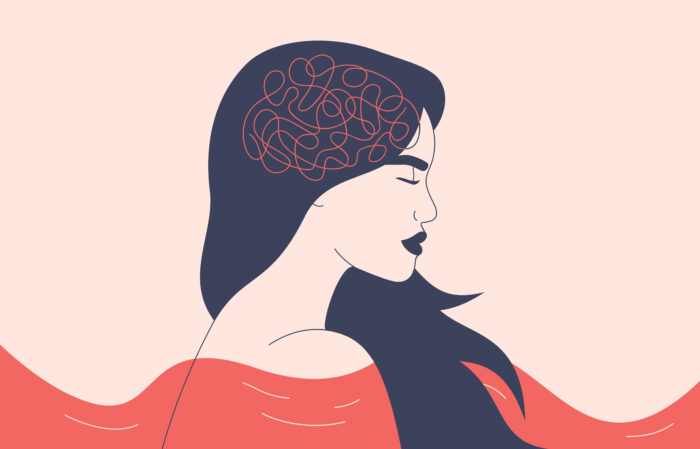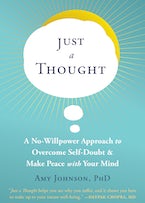By Amy Johnson, PhD, author of Just a Thought
I learned to worry at an early age.
My mom worried a lot, often aloud, and I had no clue that what she was worrying about wasn’t real. You don’t as a kid.
We were going to run out of money. We’d have to eat canned soup every night. We were going to lose our house. My dad was going to get custody of me and my sister.
It was all completely real in my mind, and I’m sure it was real in her mind too. But none of it was truly real. None of those things happened.
The things we worry about usually don’t happen because worry isn’t about what’s happening in the outside world. Worry, quite literally, is our imagination creating dramatic stories and images about things that could happen; then, our mind drops the could and talks as if what we’re worried about is inevitable.
We Evolved to Worry
Worry is the natural result of evolution.
The modern human brain evolved 200,000 years ago when survival in the environment was tenuous, at best. There were physical threats like famine and predators that required nearly nonstop present-moment focus. When early humans felt fear, it was in response to an immediate threat. There was a clear and obvious action to take, like running from the hungry looking woolly mammoth, or hunting for food to eat immediately. There was no time for worry—early humans took action and their fear subsided, end of story.
Although our brains haven’t changed much in the past 200,000 years, the world we live in has. Our brain has evolved to respond to actual danger, but with very little of that in our current environment, there is no immediate action to take to dissipate fear.
With nothing in front of you to do, your mind attaches your feelings of fear to ideas of what might go wrong at some other time. Our mind’s stories and images are brought to life in such a way that we forget they aren’t true, personal, and real.
But, they are not. They are worry.
Why Worry Seems So Real
Worry feels personal and relevant because our mind tells stories that interact with the sensory information we take in.
You watch the news and hear about COVID cases on the increase. That collection of words the news anchor says is taken by your mind and used in an incredibly creative process designed to provide a sense of certainty and predictability. Remember, your brain has evolved to predict potential disaster so that it can keep you safe. But there is no actual threat right in front of you in this very moment—you’re sitting at home on your couch, watching the news on television. So, when your creative mind begins painting pictures of you or your loved ones dying from COVID, there is nothing to do with the fear you feel. After all, in this very moment it is your imagination only. Your mind replays the stories, talking about how its stories could happen someday.
Before you know it, you’re dying of COVID in your mind with no sense that this is only happening in your imagination. It looks like an inevitable reality.
All You Have to Do Is See
Everything a mind does is its attempt to help you survive. The brain’s negativity bias and constant predictions were adapted for the survival of a species, so they aren’t likely to stop anytime soon. But seeing what’s happening with awareness can change everything.
Worry is an alarm showing us that we’re caught up in thought. If you feel fear and there is no problem demanding attention immediately in front of you, your imagination is likely creating “someday” stories about things that could happen but aren’t happening.
When you know those stories are stories, not facts, they don’t feel quite so threatening. Even better, your mind’s stories are always changing, completely on their own. There is absolutely nothing you have to do but wait. Before you know it, another well-meaning but untrue story will come around.
Amy Johnson, PhD, is a coach, author, and speaker who shares a new paradigm for how our mind works that leads to lasting freedom from anxiety, depression, insecurity, and unwanted habits. She is author of Being Human and The Little Book of Big Change, and has been a regularly featured expert on The Steve Harvey Show and in The Wall Street Journal.



 2024 Peace Playbook: 3 Tactics to Avoid Clashes with Your Partner
2024 Peace Playbook: 3 Tactics to Avoid Clashes with Your Partner